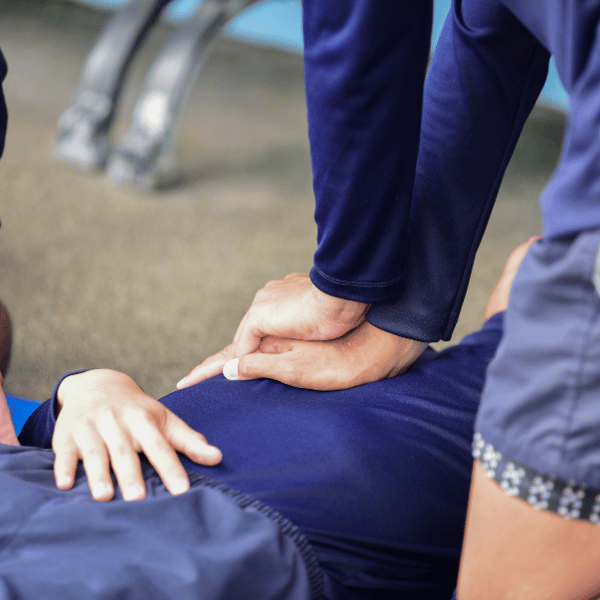
If you are faced with an adult who is choking and is not responding, knowing how CPR techniques are not the same as the usual performing of CPR skills can be very vital to saving a person’s life. CPR on a choking adult has other necessary steps, such as removing the obstruction in the airway before CPR can commence. If there is an obstructed airway, oxygen beads from getting to vital organs, so time is crucial and acting with precision. Knowledge of these exceptional ways makes it easy for the responders to perform, increasing chances of survival, so it’s a skill everyone should know. In this essay, I will discuss these important life-saving methods, what they involve, and their differences in usage in terms of how to provide the techniques during emergencies.
What is CPR and Why It’s Critical in Choking Emergencies?
CPR, or cardiopulmonary resuscitation, is a vital life-saving procedure designed to maintain blood circulation and oxygen delivery to essential organs when a person’s heart or breathing has stopped. In choking emergencies, CPR becomes especially critical if the airway is completely blocked and the individual becomes unresponsive. Without oxygen, brain damage can occur within 4 to 6 minutes, and death may follow shortly after, making immediate intervention crucial. In choking situations, CPR serves two primary purposes:- Dislodging the Obstruction: Chest compressions create pressure within the chest cavity, which can help force the object out of the airway. This is particularly important when abdominal thrusts are no longer an option due to unresponsiveness.
- Maintaining Circulation: Even if the airway remains blocked, chest compressions ensure that oxygen already present in the blood continues to circulate to vital organs, buying time until the obstruction is cleared or professional help arrives.
Key Differences Between CPR for Responsive and Unresponsive Adults
The approach to CPR varies depending on whether the choking adult is responsive or unresponsive. Understanding these differences ensures the right actions are taken at each stage of the emergency.Responsive Adult:
- Start with Abdominal Thrusts:
- Perform the Heimlich maneuver by standing behind the person, wrapping your arms around their waist, and delivering quick, upward thrusts just above the navel. This helps force air from the lungs to expel the obstruction.
- Encourage Coughing:
- If the person can still breathe partially, encourage them to cough forcefully to clear the airway. Avoid hitting their back unless they are unable to cough or the obstruction worsens.
- Avoid Chest Compressions:
- Do not perform chest compressions unless the person becomes unresponsive. Focus on clearing the airway through abdominal thrusts or back blows if necessary.
Unresponsive Adult:
- Call for Emergency Help:
- If the person loses consciousness, immediately call emergency services or instruct someone nearby to do so. Time is critical in these situations.
- Begin Chest Compressions:
- Place the heel of one hand on the center of the chest, with the other hand on top. Push hard and fast, compressing the chest at least 2 inches deep at a rate of 100–120 compressions per minute. This creates pressure that may help dislodge the object while maintaining blood circulation.
- Check the Airway After Every 30 Compressions:
- Open the airway using the head-tilt, chin-lift method. Look inside the mouth for any visible obstruction. If you see the object, carefully remove it with a finger sweep. Avoid blind sweeps, as they can push the object further into the airway.
- Deliver Rescue Breaths:
- After clearing the airway or if no obstruction is visible, give two rescue breaths. Pinch the nose shut, seal your mouth over theirs, and blow air into their lungs for about one second per breath. Ensure the chest rises with each breath. If the chest doesn’t rise, reposition the head and try again.
- Repeat the Cycle:
- Continue the cycle of 30 compressions and 2 rescue breaths until the obstruction is cleared, the person starts breathing, or emergency responders take over.
Steps to Perform CPR on an Unresponsive Choking Adult
How to Assess Unresponsiveness and Check for Breathing
Before starting CPR, it’s crucial to confirm that the adult is unresponsive and not breathing normally. Follow these steps:
-
Check for Responsiveness:
- Tap the person’s shoulders firmly and shout, “Are you okay?”
- Look for any signs of movement or response, such as blinking or groaning.
-
Check for Breathing:
- Tilt the head back slightly to open the airway.
- Look for chest movement, listen for breathing sounds, and feel for air on your cheek.
- If the person is not breathing or only gasping, treat it as a medical emergency and proceed with CPR.
-
Call for Help:
- Dial emergency services immediately or instruct someone nearby to do so.
- If you’re alone, call for help before starting CPR unless you’re trained to perform hands-only CPR.
Steps to Clear the Airway: Identifying and Removing Obstructions
Clearing the airway is a critical step when dealing with an unresponsive choking adult. Here’s how to do it effectively:
-
Open the Airway:
- Place one hand on the forehead and the other under the chin.
- Gently tilt the head back and lift the chin to open the airway.
-
Check for Visible Obstructions:
- Look inside the mouth for any visible object blocking the airway.
- If you see an object, carefully remove it using a finger sweep. Use your index finger for adults, but only if the object is clearly visible. Avoid blind sweeps, as they can push the obstruction further down.
-
Reassess the Airway:
- After removing the obstruction, check again for breathing. If the person is still not breathing, proceed with chest compressions and rescue breaths.
Performing Chest Compressions and Rescue Breaths: Correct Ratio and Technique
Once you’ve confirmed the person is unresponsive and the airway is clear, begin CPR immediately. Follow these steps to perform chest compressions and rescue breaths effectively:
-
Chest Compressions:
- Place the heel of one hand on the center of the chest, just below the nipple line. Place your other hand on top and interlock your fingers.
- Keep your arms straight and position your shoulders directly above your hands.
- Push hard and fast, compressing the chest at least 2 inches deep at a rate of 100–120 compressions per minute. Allow the chest to fully recoil between compressions.
-
Rescue Breaths:
- After 30 compressions, open the airway again using the head-tilt, chin-lift method.
- Pinch the nose shut, seal your mouth over theirs, and give a slow, steady breath lasting about 1 second. Watch for the chest to rise.
- If the chest doesn’t rise, reposition the head and try again. Deliver two breaths before returning to compressions.
-
Repeat the Cycle:
- Continue the cycle of 30 compressions followed by 2 rescue breaths until the obstruction is cleared, the person starts breathing, or emergency responders take over.
By following these steps, you can provide life-saving assistance to an unresponsive choking adult and increase their chances of recovery.
Why Chest Compressions Are Crucial in Choking Emergencies
How Compressions Help Dislodge Airway Obstructions
Chest compressions play a vital role in choking emergencies, especially when the individual becomes unresponsive. By applying firm, rhythmic pressure to the chest, compressions create a forceful upward movement of air from the lungs. This pressure can help dislodge the object blocking the airway, clearing the path for normal breathing to resume.
When the airway is completely obstructed, the body cannot expel the blockage on its own. Chest compressions act as an external force, mimicking the natural pressure changes that occur during coughing. This is particularly effective when abdominal thrusts (Heimlich maneuver) are no longer an option due to unresponsiveness.
To maximize the effectiveness of compressions, ensure they are performed correctly. Place your hands on the center of the chest, push hard and fast, and allow the chest to fully recoil between compressions. This technique not only helps dislodge the obstruction but also maintains blood circulation to vital organs while the airway is being cleared.
The Role of Rescue Breaths in Restoring Oxygen Flow
Rescue breaths are equally important in choking emergencies, as they help restore oxygen flow once the airway is cleared. After performing chest compressions, deliver two rescue breaths to ensure oxygen reaches the lungs. This step is critical because the body’s oxygen reserves deplete quickly during an obstruction, increasing the risk of brain damage or organ failure.
To give effective rescue breaths, first ensure the airway is open by using the head-tilt, chin-lift method. Pinch the nose shut, seal your mouth over theirs, and deliver a slow, steady breath lasting about one second. Watch for the chest to rise, which indicates that air is entering the lungs. If the chest doesn’t rise, reposition the head and try again.
Rescue breaths not only provide oxygen but also help assess whether the airway is still blocked. If the chest doesn’t rise after multiple attempts, return to chest compressions and continue the cycle. This combination of compressions and breaths ensures that oxygen delivery and circulation are maintained until professional help arrives.
Common Mistakes to Avoid During CPR
Errors in Chest Compression Depth and Rhythm
One of the most common mistakes during CPR is performing chest compressions with incorrect depth or rhythm. Compressions that are too shallow fail to generate enough pressure to circulate blood effectively or dislodge an airway obstruction. On the other hand, compressions that are too deep can cause rib fractures or internal injuries, especially in smaller individuals.
To avoid these errors, ensure compressions are at least 2 inches deep for adults but not excessively forceful. Maintain a steady rhythm of 100–120 compressions per minute, which aligns with the recommended pace for effective CPR. Use a metronome or count aloud to stay consistent. Allow the chest to fully recoil after each compression, as this helps the heart refill with blood and improves circulation.
Overlooking Airway Obstructions Before Starting CPR
Another critical mistake is failing to check for airway obstructions before beginning CPR. If the airway is blocked, chest compressions alone may not be enough to clear it, and rescue breaths will be ineffective. Skipping this step can delay the removal of the obstruction and reduce the chances of restoring normal breathing.
Before starting CPR, open the airway using the head-tilt, chin-lift method and look for visible obstructions. If you see an object, carefully remove it with a finger sweep, but only if it’s clearly visible. Avoid blind sweeps, as they can push the object further into the airway. Reassess the airway periodically during CPR to ensure it remains clear.
Failing to Reassess the Victim’s Condition During the Process
CPR is not a one-size-fits-all procedure, and failing to reassess the victim’s condition can lead to ineffective or unnecessary actions. For example, continuing compressions after the victim starts breathing on their own can cause harm. Similarly, ignoring signs of improvement or worsening conditions may delay necessary adjustments.
Every two minutes, pause briefly to check for signs of life, such as breathing or movement. If the victim shows signs of recovery, stop CPR and monitor their condition until emergency responders arrive. If there’s no improvement, continue the cycle of compressions and rescue breaths while ensuring the airway remains clear.
By avoiding these common mistakes, you can perform CPR more effectively and increase the chances of a positive outcome in an emergency.
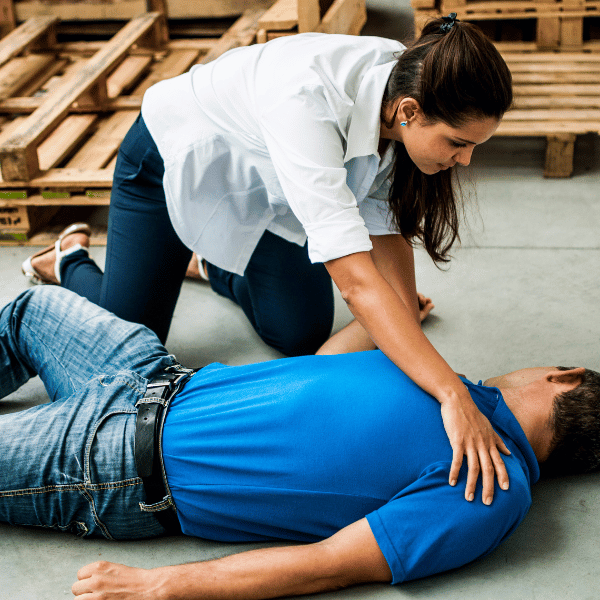
When and How to Start CPR on an Unresponsive Adult
Recognizing Signs That Indicate the Need for CPR
Knowing when to start CPR is critical in saving an unresponsive adult’s life. Begin by assessing the situation quickly and looking for these key signs:
-
Unresponsiveness:
- Tap the person’s shoulders and shout, “Are you okay?”
- If there’s no response, assume they need immediate help.
-
No Normal Breathing:
- Tilt the head back slightly to open the airway and check for breathing.
- Look for chest movement, listen for breath sounds, and feel for air on your cheek.
- If the person is not breathing or only gasping, this is a medical emergency.
-
No Signs of Circulation:
- If the person shows no signs of life, such as movement or normal breathing, start CPR immediately.
- Call emergency services or instruct someone nearby to do so before beginning chest compressions.
How to Ensure High-Quality CPR Performance
Performing high-quality CPR increases the chances of survival and minimizes complications. Follow these steps to ensure your technique is effective:
-
Positioning for Chest Compressions:
- Place the person on a firm, flat surface.
- Kneel beside them and position the heel of one hand on the center of their chest, just below the nipple line. Place your other hand on top and interlock your fingers.
-
Performing Effective Compressions:
- Push hard and fast, compressing the chest at least 2 inches deep.
- Maintain a steady rhythm of 100–120 compressions per minute. Use a metronome or count aloud to stay consistent.
- Allow the chest to fully recoil after each compression to let the heart refill with blood.
-
Incorporating Rescue Breaths:
- After 30 compressions, open the airway using the head-tilt, chin-lift method.
- Pinch the nose shut, seal your mouth over theirs, and deliver two slow breaths, each lasting about one second. Watch for the chest to rise.
- If the chest doesn’t rise, reposition the head and try again before returning to compressions.
-
Minimizing Interruptions:
- Limit pauses between compressions to no more than 10 seconds.
- If you need to check for signs of life or adjust the airway, do so quickly to maintain the flow of oxygen and circulation.
By recognizing the need for CPR early and performing it with proper technique, you can significantly improve the chances of survival for an unresponsive adult.
The Importance of Learning Adult CPR for Choking Emergencies
Benefits of CPR Training for Real-Life Scenarios
Learning adult CPR equips you with the skills to act quickly and confidently during choking emergencies. In real-life situations, every second counts, and knowing how to perform CPR can mean the difference between life and death. CPR training teaches you how to recognize signs of choking, assess unresponsiveness, and take immediate action to restore breathing and circulation.
One of the key benefits of CPR training is the ability to stay calm under pressure. By practicing techniques like chest compressions and rescue breaths in a controlled environment, you build muscle memory and confidence. This preparation ensures you can respond effectively, even in high-stress situations. Additionally, CPR training often includes guidance on using automated external defibrillators (AEDs), which can further improve survival rates in emergencies involving cardiac arrest.
CPR knowledge is not just for healthcare professionals—it’s a valuable skill for anyone, from parents and teachers to office workers and community members. By learning CPR, you become a vital link in the chain of survival, increasing the chances of saving a life when seconds matter most.
How CPR and First Aid Work Together in Emergencies
CPR and first aid complement each other, creating a comprehensive approach to handling choking emergencies and other life-threatening situations. While CPR focuses on restoring breathing and circulation, first aid addresses the immediate needs of the victim, such as clearing the airway or managing injuries.
In a choking emergency, first aid techniques like abdominal thrusts (Heimlich maneuver) are often the first step to dislodge the obstruction. If the person becomes unresponsive, CPR takes over to maintain oxygen flow and circulation until professional help arrives. Together, these skills ensure a seamless transition from initial intervention to life-saving measures.
For example, during CPR, you may need to perform a finger sweep to remove visible obstructions from the airway. This action, rooted in first aid principles, works hand-in-hand with chest compressions and rescue breaths to clear the airway and restore normal breathing. By combining CPR and first aid, you can address the full scope of the emergency, from identifying the problem to providing effective care.
Learning both CPR and first aid empowers you to handle a wide range of emergencies, making you a more capable and confident responder. These skills not only save lives but also provide peace of mind, knowing you’re prepared to act when it matters most.
Advanced Tips for Effective CPR in Choking Situations
Integrating Chest Thrusts and Compressions for Better Results
In choking emergencies, combining chest thrusts with compressions can enhance the chances of dislodging the obstruction. Chest thrusts, similar to abdominal thrusts, apply focused pressure to the chest, creating a forceful upward movement of air that can help expel the blockage.
To integrate chest thrusts effectively:
- Switch to Chest Thrusts When Needed: If abdominal thrusts are not an option (e.g., for pregnant individuals or those with obesity), use chest thrusts instead. Place your hands on the center of the chest and push inward and upward with controlled force.
- Alternate with Compressions: For unresponsive individuals, perform chest compressions as part of the CPR cycle. These compressions not only circulate blood but also generate pressure that may help clear the airway.
- Focus on Proper Technique: Ensure that chest thrusts and compressions are deep enough (at least 2 inches for adults) and performed at the correct rhythm (100–120 per minute). Allow full chest recoil between each thrust or compression to maximize effectiveness.
By combining these techniques, you can address both the immediate need to clear the airway and the critical requirement to maintain circulation.
Understanding the CPR Cycle and When to Adjust Techniques
The CPR cycle consists of 30 chest compressions followed by 2 rescue breaths, repeated continuously until the obstruction is cleared or professional help arrives. However, knowing when and how to adjust your approach is key to effective CPR in choking situations.
- Reassess the Airway Regularly: After every set of 30 compressions, check the airway for visible obstructions. If you see the object, carefully remove it using a finger sweep. Avoid blind sweeps, as they can push the blockage further down.
- Adapt to the Victim’s Response: If the person shows signs of life, such as coughing, breathing, or movement, stop compressions and monitor their condition. Be ready to resume CPR if they become unresponsive again.
- Adjust for Special Circumstances: In cases where the victim has a medical condition or physical limitation, modify your technique as needed. For example, use chest thrusts instead of abdominal thrusts for pregnant individuals.
- Minimize Interruptions: Limit pauses between compressions to no more than 10 seconds. Quick transitions between compressions, airway checks, and rescue breaths ensure continuous oxygen delivery and circulation.
Understanding the CPR cycle and adapting your techniques based on the situation ensures that your efforts remain effective and responsive to the victim’s needs. These advanced tips can make a significant difference in choking emergencies, improving the chances of a successful outcome.
Frequently Asked Questions
Q: What makes CPR on an unresponsive adult who is choking different from performing it on an adult who is not choking?
A: Performing CPR on an unresponsive adult who is choking differs from standard adult CPR, primarily in the importance placed on airway clearance. When thrusting air for a conscious individual and getting an obstructed airway, one will thrust their hand into their stomach to clear the airway before performing CPR. If the adult becomes unconscious, the person performing the adult CPR will check for the object in the airway, remove it if present, and then proceed to perform the adult CPR.
Q: What should be done when an adult victim who is choking becomes unconscious?
A: First, you need to get everyone on the same page by calling emergency services while checking the adult’s mouth for residuals sticking to the roof. If the object is peeking, try to punch it out at all costs. If it does not work, use your trained CPR skills by thrusting compressions into the torso for unresponsive adults. Perform 30 thrusts and then shift to puffs. If it dislodges, attempt to breathe inside their lungs.
Q: What is the required pressing rate during CPR when dealing with an adult coma victim?
A: In the case of an adult coma victim, the required pressing rate during CPR is 100 to 120 cycles each minute. This rate of practice conforms to the contemporary adult CPR rules. This is vital because of sufficient blood circulation for blood flow to the heart and brain.
Q: Why do you think it is necessary to do airway management in an unresponsive adult who is choking?
A: Airway management is critical in an unresponsive, choking adult because if there is an obstruction, it could prevent air from getting to the lungs, resulting in brain injury or death. Freeing the airway ensures the patient can breathe, which is essential before starting CPR.
Q: What are the differences between adults and infants regarding CPR if they choke?
A: The difference between adults' and infants' CPR in case they choke is that the technique used differs for each group when giving chest compressions and dealing with their airway. Two fingers would be employed for infants instead of two hands for compressions. Also, when the infant is choking, back blows and chest thrusts would be used, but adult abdominal thrusts would be used.
Q: What is the sequence of steps to follow when performing CPR for unresponsive adults who are choking?
A: The sequence of steps includes: first, call for emergency services, then check the mouth for any obstructions, Attempt to remove anything visible, and, if the person is unresponsive, start performing CPR. First, perform 30 compressions on the chest at the rate of 100 -120 times per minute, then give two breaths and repeat the sequence of 5 times CPR cycles until emergency medical aids arrive or the victim is reacting to the actions performed.
Q: Is it possible to do hands-on CPR for an adult choking victim who is unresponsive?
A: Hands-only CPR can be done on an adult choking victim who is unresponsive, provided the rescuer is unable to give rescue breaths. First, however, removing whatever is blocking the airway is essential. Afterward, hands-on CPR can be conducted efficiently if the airway is not obstructed.
Q: I want to learn CPR and how to handle choking situations effectively; how would I go about this?
A: The Red Cross and American Heart Association offer CPR certification courses that can train you to perform CPR. These courses address choking procedures for both adults and pediatric patients. You will receive training to respond to such scenarios and practice skills that are considered vital.
References
- HeartStart CPR: This source explains the differences in CPR techniques for choking victims, emphasizing the use of abdominal thrusts when the victim is responsive.
- Simple CPR: This article discusses the importance of clearing the airway first in unresponsive choking victims before proceeding with CPR.
- CPR Professionals: This source highlights the priority of chest compressions over rescue breaths in the case of an unresponsive choking victim.


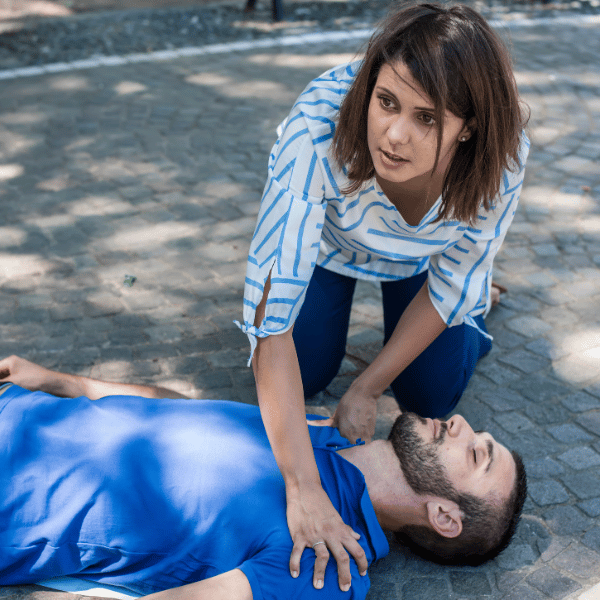
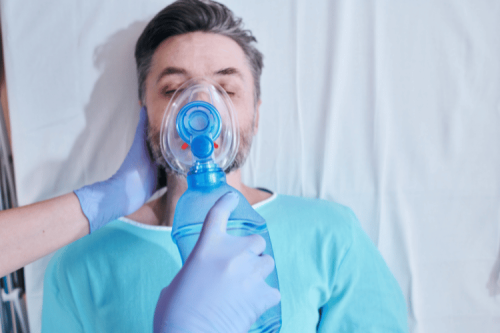
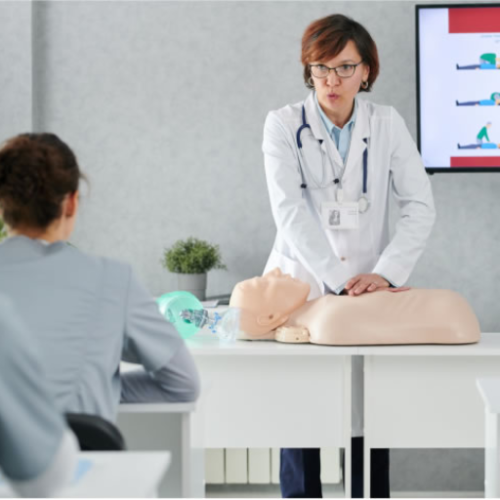
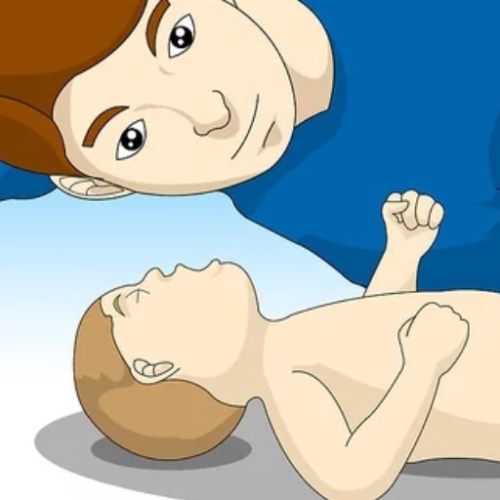

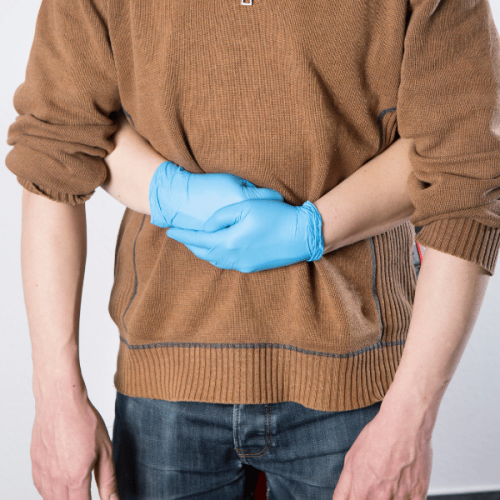
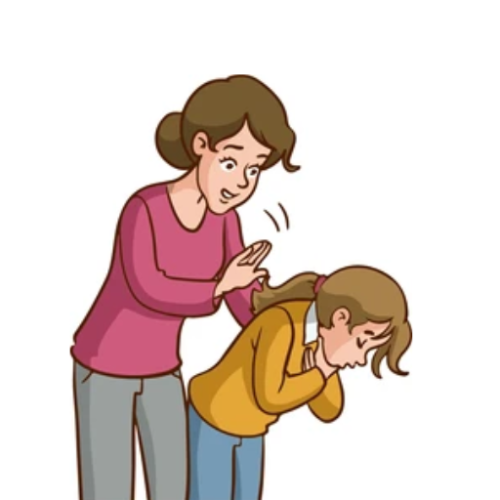
 Login with Google
Login with Google Login with Facebook
Login with Facebook